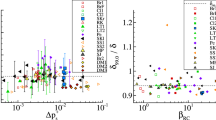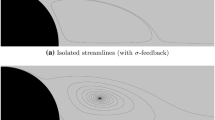Abstract
The V2F model makes use of the standard k–ε model, but extends it by incorporating near-wall turbulence anisotropy and non-local pressure-strain effects, while retaining a linear eddy viscosity assumption. It has the attraction of fewer equations and more numerical robustness than Reynolds stress models. The model is presented in a form that is completely independent of distance to the wall. This formalism is well suited to complex, 3-D, multi-zone configurations. It has been applied to the computation of two complex 3-D turbulent flows: the infinitely swept bump and the appendage-body junction; some preliminary results for the flow in a U-bend are also presented. Despite the use of a linear, eddy viscosity formula, the V2F model is shown to provide excellent predictions of mean flow quantities. The appendage-body test case involves very complex features, such as a 3-D separation and a horseshoe vortex. The V2F simulations have been shown to successfully reproduce these features, both qualitatively and quantitatively. The calculation of the complex flow structure inside and downstream of the U-bend also shows very promising results.
Similar content being viewed by others
References
Behnia, M., Parneix, S. and Durbin, P., Accurate predictions of jet impingement heat transfer. In: HTD-Vol. 343, National Heat Transfer Conference, Baltimore, Vol. 5 (1997) pp. 111–118.
Behnia, M., Parneix, S. and Durbin, P., Prediction of heat transfer in a jet impinging on a flat plate. International Journal of Heat and Mass Transfer 41 (1998) 1845–1855.
Behnia, M., Parneix, S. and Durbin, P., Numerical simulation of jet impingement cooling of a heated pedestal. In: Proceedings of 10th International Symposium on Transport Phenomena. Kyoto (1997) Vol. 2, pp. 349–354.
Benek, J.A., Bunning, P.G. and Steger, P.G., Chimera: A grid-embedding technique. AIAA Paper No. 85-1523 (1985).
Benek, J.A., Donegan, T.L. and Suhs, J.L., Extended Chimera grid-embedding scheme with applications to viscous flows. AIAA Paper No. 87-1126 (1987).
Cheah, S.C., Iacovides, H., Jackson, D.C., Ji, H. and Launder, B. Measurements of an enclosed rotor-stator disc flow. In: Symposium on Laser Anemometry on Reciprocating, Reacting or Rotating Flow, University College of Swansea, 7-9 April (1992).
Cheah, S.C., Iacovides, H., Jackson, D.C., Ji, H. and Launder, B., LDA investigation of the flow development through rotating U-ducts. In: Proceedings International Gas-Turbine and Aero Congress, The Hague (1994) ASME paper 94-GT-55, pp. 590–596.
Chen, H.C., Assessment of a Reynolds stress closure model for appendage-hull junction flows. Journal of Fluid Engineering 117 (1995) 557–563.
Craft, T.J. and Launder, B.E., A Reynolds stress closure designed for complex geometries. International Journal of Heat and Fluid Flow 17 (1996) 245–254.
Craft, T.J., Launder, B.E. and Suga, K., Prediction of turbulent transitional phenomena with a non-linear eddy-viscosity model. International Journal of Heat and Fluid Flow 18 (1997) 15–28.
Deng, G., Rèsolution des èquations de Navier—Stokes tridimensionnelles. Application au calcul d'un raccord plaque plane-aile. Ph.D. Thesis, University of Nantes, France (1989).
Devenport, W. and Simpson, R., Time-dependent and time-averaged turbulence structure near the nose of a wing-body junction. Journal of Fluid Mechanics 210 (1990) 23–55.
Durbin, P., Near-wall turbulence closure without damping functions. Theoretical and Computational Fluid Dynamics 3(1) (1991) 1–13.
Durbin, P., A Reynolds-stress model for near-wall turbulence. Journal of Fluid Mechanics 249 (1993) 465–498.
Durbin, P., Application of a near-wall turbulence model to boundary layers and heat transfer. International Journal of Heat and Fluid Flow 14(4) (1993) 316–323.
Durbin, P., On modeling three-dimensional turbulent wall layers. Physics of Fluids A 5 (1993) 1231–1238.
Durbin, P., Separated flow computations with the k-ε-ν2— model. AIAA Journal 33(4) (1995) 659–664.
Bonnin, J.C., Buchel, T. and Rodi, W., Databases and testing of calculation methods for turbulent flows. Ercoftac Bulletin 28 (1996) 49–54.
Gibson, M.M. and Launder, B.E., Ground effects on pressure fluctuations in the atmospheric boundary layer. Journal of Fluid Mechanics 86 (1978) 491–511.
Goldberg, U. and Reshotko, E., Scaling and modeling of three-dimensional, pressure-driven turbulent boundary layers. AIAA Journal 22 (1984) 914–920.
Hanjalic, K., Advanced turbulence closure models: A view of current status and future prospects. International Journal of Heat and Fluid Flow 15 (1994) 178–203.
Iacovides, H. and Launder, B.E., Computational fluid dynamics applied to internal gas-turbine blade cooling: A review. International Journal of Heat and Fluid Flow 16 (1995) 454–470.
Iacovides, H., Launder, B.E. and Li, H.Y., The computation of flow development through stationary and rotating U-ducts of strong curvature. International Journal of Heat and Fluid Flow 17 (1996) 22–33.
Ji, H., An experimental investigation of two rotating turbulent shear flows with gas turbine applications. Ph.D. Thesis, Department of Mechanical Engineering, UMIST (1994).
Johnston, J.P. and Flack, K.A., Review — Advances in three-dimensional turbulent boundary layers with emphasis on the wall-layer regions. Journal of Fluid Engineering 118 (1996) 219–232.
Launder, B.E., Turbulence modelling for flows in arbitrarily complex domains. In: Eccomas. John Wiley & Sons, New York (1996).
Martinuzzi, R. and Tropea, C., The flow around surface-mounted, prismatic obstacles placed in a fully developed channel flow. Journal of Fluid Engineering 115 (1993) 85–92.
Moin, P., Shih, T.H., Driver, D.M and Mansour, N.M., Direct numerical simulation of a three dimensional turbulent boundary layer. Physics of Fluids A 2 (1990) 601–639.
Simoneau, R.J. and Simon, F.F., Progress towards understanding and predicting heat transfer in the turbine gas path. International Journal of Heat and Fluid Flow 14 (1993) 106–127.
Ölçmen, S. and Simpson, R., An experimental study of a three-dimensional pressure-driven turbulent boundary layer. Journal of Fluid Mechanics 290 (1995) 225–262.
Ölçmen, S. and Simpson, R., Some features of a turbulent wing-body junction vortical flow. In: 35th Aerospace Sciences Meeting and Exhibit. (1997) AIAA Paper No. 97-0651.
Praisner, T.J., Seal, C.V., Takmaz, L. and Smith, C.R., Spatial-temporal turbulent flow-field and heat transfer behavior in end-wall junctions. International Journal of Heat and Fluid Flow 18 (1997) 142–151.
Rodi W., Bonnin, J.C., Buchal, T. and Laurence, D., Testing of Calculation Methods for Turbulent Flows: Workshop Results for 5 Test-Cases. EDF Report. EFD (1998) 98NB00004, ISSN 1161-0611.
Rodi, W. and Mansour, N.N., Low Reynolds number k-ε modeling with the aid of direct simulation data. Journal of Fluid Mechanics 250 (1993) 509–529.
Rogers, S.E. and Kwak, D., Upwind differencing scheme for the time-accurate incompressible Navier—Stokes equations. AIAA Journal 28 (1990) 253–262.
Schwarz, W. and Bradshaw, P., Turbulence structural changes for a three-dimensional turbulent boundary layer in a 30° bend. Journal of Fluid Mechanics 272 (1994) 183–209.
Spencer, M.C., Jones, T.V. and Lock, G.D., Endwall heat transfer measurements in an annular cascade of nozzle guide vanes at engine representative Reynolds and Mach numbers. International Journal of Heat and Fluid Flow 17 (1996) 139–147.
Sung, C.H. and Yang, C.I., Validation of turbulent horseshoe vortex flows. In: 17th Symposium on Naval Hydrodynamics, The Hague (1988).
Xie, Q. and Wroblewski, D., Effect of periodic unsteadiness on heat transfer in a turbulent boundary layer downstream of a cylinder-wall junction. International Journal of Heat and Fluid Flow 17 (1996) 107–115.
Webster, D.R., DeGraaff, D.B. and Eaton, J.K., Turbulence characteristics of a boundary layer over a two-dimensional bump. Journal of Fluid Mechanics 320 (1996) 53–69.
Webster, D.R., DeGraaff, D.B. and Eaton, J.K., Turbulence characteristics of a boundary layer over a swept bump. Journal of Fluid Mechanics 323 (1996) 1–22.
Wu, X. and Squires, K.D., Nonequilibrium turbulent flow over a bump: A comparison of LES and RANS with experiments. AIAA Journal 38 (1998) 799–808.
Wu, X. and Squires, K.D., Prediction of the three-dimensional turbulent boundary layer over a swept bump. AIAA Journal 36(4) (1998) 505–514.
Rights and permissions
About this article
Cite this article
Parneix, S., Durbin, P. & Behnia, M. Computation of 3-D Turbulent Boundary Layers Using the V2F Model. Flow, Turbulence and Combustion 60, 19–46 (1998). https://doi.org/10.1023/A:1009986925097
Issue Date:
DOI: https://doi.org/10.1023/A:1009986925097




